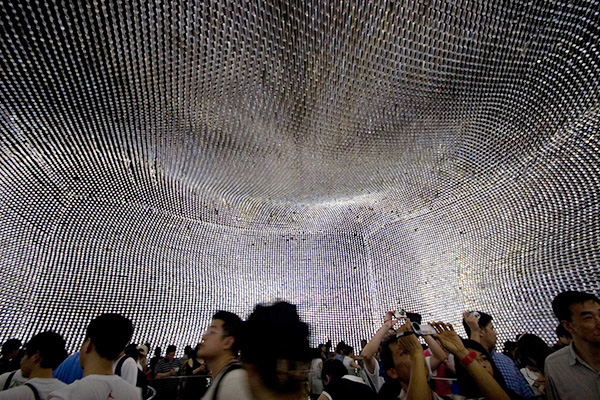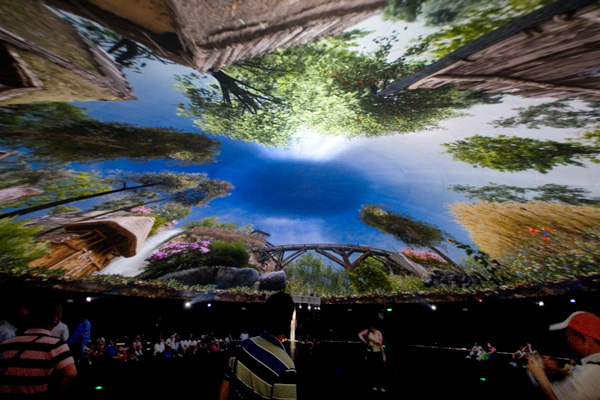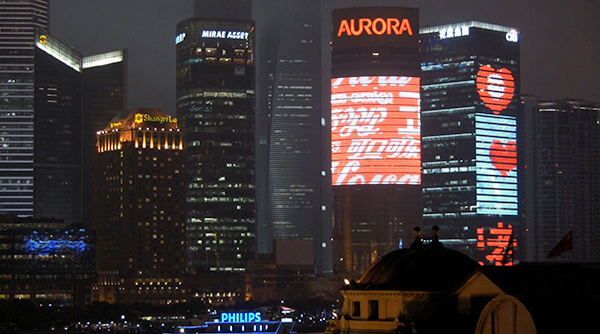Documenting Spectacle: An Artist’s Notes on the Shanghai Expo
by Meghann McCrory

The Urbanian Pavillion, designed by Kossmann.deJong, at Expo Shanghai 2010. All photos by Meghann McCrory.
In June, I visited Expo Shanghai 2010, the largest world’s fair in history. A central part of my artistic practice has focused on ideas of utopia and paradise and their expression in architecture and landscaping. These interests led me to the history of glass architecture, and to world’s fairs as a key line in that genealogy. World’s fairs have always been to some degree about the future, and glass has a long history of symbolizing various utopian tomorrows. From the Crystal Palace to Buckminster Fuller’s biosphere, the fairs have featured colossal displays of mind-bending architecture and breakthrough technological gadgetry in a performance of economic and cultural virility.
As an artist based in Los Angeles, a city often referred to as postmodern, or, my favorite, the “Supercity of the Future,”1 I’ve investigated California as a landscape produced through vast public relations campaigns that rely on utopian and paradisiacal mythologies.2For example, an 1893 pamphlet produced, incidentally, by the Southern California World’s Fair Association, promotes California as a land with inherent health-promoting qualities, a place “where winter is unknown” and farmers may grow exotic fruits year round, emphasizing its striking resemblance to the Promised Land “flowing with milk and honey.”3The more I researched the Expo, the more it seemed that if Los Angeles was the future of yesterday, perhaps Shanghai might be the future of today. I felt compelled to find out what this future might promise.
On another level, my interest in the Expo came out of a desire to understand the relationship between the images I was seeing online of the pavilions’ construction and the embodied experience of actually being there, to discover what might be at stake in physically experiencing the spectacle, and to see if its magic would work or if I might find a frayed edge.4I fell in love with images of the Sun Valleys—enormous glass-and-steel conical structures that lined the main axis of the site—even while my critical self cautioned against such undisciplined looking. And so I flew to see them in person, unsure if I was looking for seduction, or looking for a fight. In the end, I found both.
Some numbers: Open from May 1 to October 31, 2010, the Expo included participants from 228 nations and international organizations, in hundreds of pavilions. More than 18,000 families and 272 factories were relocated to clear 1,300 acres in the middle of one of the largest metropolitan areas of the world. The city of Shanghai spent an estimated $45 billion dollars on construction, infrastructure, and promotion. The official attendance count stands at a little more than 73 million visitors.5

Interior of the UK Pavilion, designed by Thomas Heatherwick. 60,000 fiberoptic acrylic rods embedded with unique seeds from the Kew Gardens seed bank in London.
From the tourist photo op to the ubiquitous colossal video screens, the Expo was a landscape composed of images. In a metaphorical sense, the fair sought to create a new image of China in the 21st century—for the world and perhaps even more for its own citizens—of a progressive, technologically advanced nation that is boldly embracing its rapid economic growth and is optimistic about solving the ecological and social challenges that accompany it. The fair accomplished this through the production of a vast spectacle that was meant to inspire and entertain, to impress and overwhelm. It was built for the camera, but also resisted the photograph; two-dimensional representations of the immersive spaces are often illegible, flattening out into a collage of image within image within image. In my own installation work, I’ve often layered images from diverse sources to illustrate the multifaceted representation and production of place, and the enduring influence of archetypes in our popular iconography. A hall of mirrors on the scale of the Expo was a particular thrill, and the rich combination of historical, pop, and fantastical imagery made for a dizzying encounter.
If the Expo is a monumental yet ephemeral set built for the camera, the Shanghai skyline in a neighborhood called Pudong is its more permanent architectural analogue. With its soaring electroluminescent skyscrapers, it is more of a backdrop for a city than a city itself. It is postcard-ready, situated across the river, at a perfect viewing distance for the tourist’s camera, which is blind to the fact that much of the office space is empty. Both the Expo and the broader campaign to redevelop the city are part of an effort to recast Shanghai as the new economic center of China, and China as an economic center of the world. The skyline provides the logo. This is a landscape performing itself, rebranding itself, in a complexly choreographed negotiation of its past and future.
Extraordinary architectural structures surely must accompany any convincing utopian argument about the future. This Expo, like those before it, was a playground for experimental architecture. Unconcerned with long-term constraints, this is architecture freed from typical utilitarian concerns, unbound by the limits of urban planning. Some pavilions showcased feats of architectural ingenuity that bordered on the sculptural, like the UK pavilion, with its 60,000 acrylic rods each embedded with unique seeds from Kew Gardens in London. The Swiss pavilion featured a ski lift that ascended through a vertical garden to fly over hills of alpine wildflowers, with Shanghai in the background to create an uncanny juxtaposition of nature and city, East and West. The Taiwan pavilion impressed with sheer high-tech glitz in the form of an animated spherical video screen fifty feet in diameter.

“The Only Planet We Have,” an immersive panoramic film at the Pavilion of Urban Planet, conceived and designed by Triad Berlin Projektgesellschaft.
The utopian theme played out dramatically in an immersive film titled “The Only Planet We Have” at the Pavilion of Urban Planet. A massive domed projection that stretched over and around the audience, it was a sensational combination of 19th century panoramas, planetarium shows, and high-definition computer-generated graphics. The animation illustrated the settlement of the countryside, industrialization, collapse into an apocalyptic nightmare of pollution, and the resurrection of the city thanks to wind turbines and futuristic high-rises. Disorienting, loud and overwhelming, its immersive nature precluded me from seeing the “whole” film, as my shifting gaze reframed and thus edited it. It was an event that resisted reproduction—there is no way to upload it to YouTube, and photographs border on the illegible. In an age when the act of posting a picture to your profile is as important as attending the event it documents, this kind of spectacle occupies an odd place in a media landscape that privileges the rectilinear, the two-dimensional. The re-presentation of it seems to particularly miss the point. It can only exist on site, in that space, and as such probably won’t earn a strong presence in the archive of online media, becoming a ghost both because of and in spite of its particular power as spectacle. This move toward immersion might be seen as part of a broader trend in architecture and entertainment. From 3-D movies to the Grove, an outdoor mall in Los Angeles where it snows on Christmas, designers must make ever more dramatic efforts to dazzle an audience numb to the proliferation of images.
Given that China is urbanizing faster than any country in the world, this nightmare of ecological disaster was likely familiar to many of those traveling to the Expo from the countryside. The film’s narrative acknowledges this while impressing the viewer with its sheer spectacular technological prowess, a layered message about technology’s utopian potential to solve the problems of modernization, illustrated both denotatively in the story of the film and connotatively in the experience of its spectacle. In other words: don’t worry, technology will fix itself. Pure propaganda. Totally exhilarating.
The power of spectacle relies on this experience of being overwhelmed, which is both to be dazzled and dominated. The more I considered spectacle as a phenomenon, the more it became clear that scale and the relationship to the body is essential to this sense of domination.6At the Expo, visitors traversed the site by means of elevated walkways or on fleets of sparkling electric buses and vans that silently sped along eight-lane roadways below. One was constantly aware of the site’s scale, either way. In contrast, Disneyland is consciously constructed such that the viewer feels like an active participant rather than a dominated viewer. The buildings on Main Street are three-quarter scale, and the vast infrastructure that makes it possible is laboriously hidden. Even as Disneyland feels endless, it is also intimate, a playground where the audience is made to feel privileged and empowered to engage, if in a meticulously scripted sense. The Expo, on the other hand, emphasized the ambitious scale of both the event and the vast crowds they planned for, dwarfing the individual.7But around these controlled crowds, the empty spaces and their wanton layout ensured that the pavilions remained visible from a great distance, while still evoking an extreme sense of dislocation. The pavilions seemed to grow and shrink, depending on the vantage point, refusing to provide a stable set of landmarks by which to navigate. In this state of disorientation and distraction, the viewer was always aware of the monumentality of the production as a whole. Overall, it wasn’t beautiful, though it may have approached the sublime.

The Pavilion of Urban Future, designed by Ingeniaqued.
Constructed for maximum visual impact, the pavilions each have an idealized view, where the overall structure is most impressive and total, as evidenced in the architectural renderings on the Expo website.8On the ground, that view is almost impossible to achieve: endless queues, crowds of tourists snapping photos, food kiosks, and bathrooms obscure the pristine forms imagined by the architects. Even so, the experience for many visitors seemed to be one of continuous documentation, and people’s expressions were often oddly ambivalent in comparison with their photojournalistic dedication.
The Expo as represented online is an idealized landscape, marred by the fact that in order for it to have happened, it had to happen in real time, and suffer the accompanying indignities of messy reality: rain, trash, obscured views, the spaces in between pavilions, the backs of buildings. If the pavilions were originally conceived with an ideal vantage point, it is one that ceases to exist as soon as the structure comes into being. One photo booth offered a neat solution to this problem by montaging visitors’ images onto the professional Expo photograph of choice. It’s no wonder the brilliant architectural renderings on the official website haven’t been replaced with “real” photographs, which are surely less convincing. The difference between fact and fiction, document and fantasy no longer matters when the image functions as proof that the visitor was “there,” and “there” is more of an idea than a place.
This notion of landscape as symbolic space doesn’t end at the gates of the Expo, but extends across the city of Shanghai, which is being reconfigured at an astonishing pace. In the same way that the state used the Olympics to clean up Beijing, officials embraced the Expo as an opportunity to give Shanghai a 21st century makeover. In the midst of a dramatic urban redevelopment initiative that is remaking the city block by block, the traditional shikumen neighborhoods are being erased to make way for modern apartment buildings, whole communities relocated at the service of large urban construction projects.9However, ever-savvy to the importance of the image, officials put construction on hold to reduce the dust that typically fills the air, and the recently bulldozed blocks that pockmark the city were camouflaged behind massive temporary walls wrapped in a skin of slick advertisements.
Shanghai is already home to the third-tallest building in the world, and a skyscraper to beat that one is almost finished, which will secure the city as the location of the second and fourth tallest buildings in the world, at least for the moment.10Not only are the buildings colossal, several are also covered in some of the largest video screens in the world, which play cycles of dazzling animated advertisements. These are buildings as billboards, towering over a city as digital media, a landscape one can literally watch like television.

Pudong skyline, with neoclassical bank buildings in the foreground. View from the Captain Hostel rooftop restaurant.
The self-conscious construction of skyline as symbol isn’t unique to China, of course. David Rockefeller was similarly inspired when he proposed construction of the World Trade Center to recast downtown Manhattan as a symbol of economic might. The Bunker Hill Redevelopment Project cleared swaths of downtown Los Angeles in the 1960s to make way for the skyscrapers that, until then, the city lacked and needed to prove its contested urban identity. However, in Shanghai, instead of replacing one kind of urban development with another, these colossal buildings are built on what only twenty years ago was farmland. This move, directly from an agricultural space to a megacity icon, speaks to the pace of change there.
The best, and intended, view of the Pudong skyline is from across the river on the Bund, a strip of breathtaking Neoclassical buildings built by European banks in the 1920s and 1930s, that are both a source of pride and a reminder of Shanghai’s bitter colonial past. The new skyline takes advantage of the Bund’s cultural and historical appeal while asserting a new era of economic development, this time fully steered by the Chinese. The skyline—the future—is seen from the Bund—the past. The view from the skyscrapers themselves, many topped with five-star restaurants and luxury bars, is reputed to be disappointing. The real view is of the skyline, not from it, and taking the picture from across the river becomes the primary rather than secondary experience of the buildings.
As of winter 2010, all but five of the pavilions that fill the 1,300 acres of the Expo site had been demolished. Some of the exhibits will migrate to a museum on site, but most of the pavilions will simply be carted to the landfill. What will become of the site is still unclear, and the evolution to its next phase will likely take years, though it seems reasonable to assume it will be converted to malls, hotels, and other tourist attractions. All that will be left of the idiosyncratic and fanciful pavilions will be the millions of mostly mediocre photographs gathering dust, so to speak, on hard drives across China and the world. The skyline will increasingly dominate as the primary logo for Shanghai, a companion to the few permanent structures left at the Expo site, and the photographs taken home by the 70 million tourists will serve as advertisements for this glittering city. The views across the river when I was there in June were that much more striking because of the atypically clear skies, which ensured that the frenzied crowds of tourists could snap pictures scrubbed clean of the repercussions from China’s rapid industrial development. Given that much of the particulate pollution in Los Angeles travels here on the jet stream from China, perhaps the skies were a little bluer for tourists in downtown LA, as well.11And the picture, after all, is what matters.